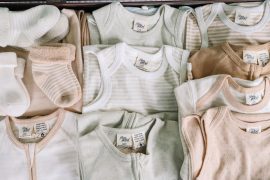By Bailey Petrucelli
We are bombarded with ads everyday about the latest fashion trends and newest must-haves for the upcoming season. Fashion industries are advertising new trends every season which has adapted to every week. The industry makes you believe that what was in last month or even last week, is no longer in style.
As a parent, you may want your baby to have the cutest clothes and have Pinterest-inspired photos to remember your little one’s every stage of life. You feel obligated to stay up to date with the latest trends – even if your baby outgrows the items within a couple weeks.
Has the fashion industry gone too far in promoting their clothes? Have we gone too far in buying our children new clothes for every {fashion} season?
What is Fast Fashion?
As the fashion industry is booming, they need more seasons and reasons for people to buy their products. Customers are demanding more trends and the fashion industry to supplying it.
However, for most corporate fashion industries to keep up with this high-speed production, they need to outsource their manufacturing to developing countries.
These companies can produce their goods at a dangerously low cost at an extremely quick pace. They continue to proceed this way because they are able to, it saves the company money, and we, as customers, keep demanding it as we buy their latest fashions. They aren’t the best quality, leaving us to come back for more when the clothes get holes easily or stretched out easily.
Fast fashion lets us purchase the latest trends at a cheap price. Sadly, there is a bigger price we are paying for this arrangement – damaging our environment, health and communities.
What’s the Issue with Fast Fashion?
Because many companies can outsource their manufacturing to other countries, they can get away with paying lower salaries to workers and don’t have to pay their workers benefits. The working conditions are often horrid with overcrowded factories and/or unsafe machinery. This can lead to illnesses, factory fires, and even buildings collapsing.
To be able to produce the amount of fibers needed to stay up with production demands, pesticides are used to create the largest amount of fibers, with the smallest land available. Pesticides keep the plants safe from certain insects and diseases. However, the consequences of using these pesticides can be devastating to communities.
Fast fashion lets us purchase the latest trends at a cheap price. Sadly, there is a bigger price we are paying for this arrangement – damaging our environment, health and communities.
Pesticides can remain in the run off and enter into the waterways, destroying ecosystems in the surrounding areas and even hundreds of miles away. Synthetic dye from coloring the clothes can have the same effects. The toxic chemicals go into the waterways, turning whole rivers or ponds into bright colored water, killing the marine life.
Pesticides have shown to increase certain types of disease and cancers with high exposures. There are communities covered in pesticide smog, with astounding rates of deformities in newborns and children.
It’s not only the workers that are injured from fast fashion, but it’s their families and communities that are being harmed as well.











